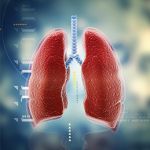
Kostiantyn Voitenko / shutterstock.com
ACR CONVERGENCE 2020—Tiphanie Phillips Vogel, MD, PhD, assistant professor of pediatrics and internal medicine at Baylor College of Medicine, Houston, moderated the session on COPA syndrome, which drew 324 attendees on a Sunday morning. This rare genetic cause of immune dysregulation can present like anti-neutrophil cytoplasmic antibody (ANCA) associated vasculitis, lupus, lupus nephritis or rheumatoid arthritis with interstitial lung disease.
Afterward, she spoke with The Rheumatologist. “There’s no chance this is as rare as is currently reported,” emphasizes Dr. Vogel, who believes many cases of COPA syndrome are undiagnosed. She does not want rheumatologists to miss the diagnosis. She hopes the session prompted clinicians to ask themselves, “I wonder if I have a COPA syndrome patient in my clinic?”
Presentation
Patients who develop symptoms of COPA syndrome always have lung disease, approximately half have inflammatory arthritis, and a quarter have glomerulonephritis. Diagnosing the syndrome can be confusing, because the mutation does not have 100% penetrance, meaning some carriers of the COPA mutation have no symptoms. These overlapping patient presentations can be puzzling, says Dr. Vogel.
During the session, she described the first patient she saw with COPA syndrome: The patient presented as a teenager, with pulmonary hemorrhage—a phenomenon experienced by approximately half of patients with COPA syndrome—and glomerulonephritis. The family was known to the hospital because the patient’s brother was being treated for juvenile idiopathic arthritis (JIA). Additional family history was significant for several relatives with rheumatoid arthritis.
This family history prompted genetic testing and revealed the family has COPA syndrome. When the treatment team circled back to examine the lungs of the brother with JIA, they found that although he was not known to have lung disease, he did, indeed, have it, but the disease was not as severe in his case as in his sister’s.
Dr. Vogel has published on this family.1 Her reports join others to document a total of 48 patients. Her team is currently at work on a literature review of these patients and their treatment, but Dr. Vogel points clinicians who are eager to learn more now to a review published in the April issue of the Journal of Clinical Immunology.2
Although half of COPA syndrome patients develop their first symptoms when they are younger than 5 years old, approximately 10% of patients first present as adults.
She describes three typical presentations of a patient with COPA syndrome. The first is a young patient (including toddlers) with early onset of pulmonary hemorrhage. The second is a teenager with interstitial lung disease whose family history includes individuals with rheumatoid arthritis. This describes the above-described COPA syndrome patient at Baylor. The third presentation that should raise the index of suspicion for COPA syndrome is a family of individuals with vasculitis. Dr. Vogel emphasizes that familial vasculitis is highly unusual.
These three presentations underscore the importance of obtaining a thorough family medical history. Given the prevalence of rheumatoid arthritis, Dr. Vogel says rheumatologists may be inclined to dismiss the presence of rheumatoid arthritis in a patient’s family as an indicator of a COPA mutation. However, nearly two-thirds of COPA syndrome patients are rheumatoid factor positive. Therefore, because COPA syndrome patients can have undiagnosed lung involvement, she urges rheumatologists to let the presence of a family history of rheumatoid arthritis trigger suspicion of COPA syndrome in patients with interstitial lung disease.
If a clinician suspects a patient has COPA syndrome, the patient should be sent for genetic sequencing. Any exome sequencing, although expensive, will find a COPA mutation. Dr. Vogel identified several companies that have COPA on their genetic panels, and these tests can be more reasonable (for example, $250 out of pocket). These companies include Invitae, Fulgent Genetics and PulmZoom.
Dr. Vogel explains that a diagnosis of COPA syndrome is important because it changes disease prognosis for children. Often pediatric rheumatology patients can achieve long-term remission, but patients with COPA syndrome may not be able to achieve sustained remission without medication. In addition, because COPA syndrome is a genetic disease, patients should be referred to a genetic counselor, something Dr. Vogel does when her patients become sexually active or head off to college.



